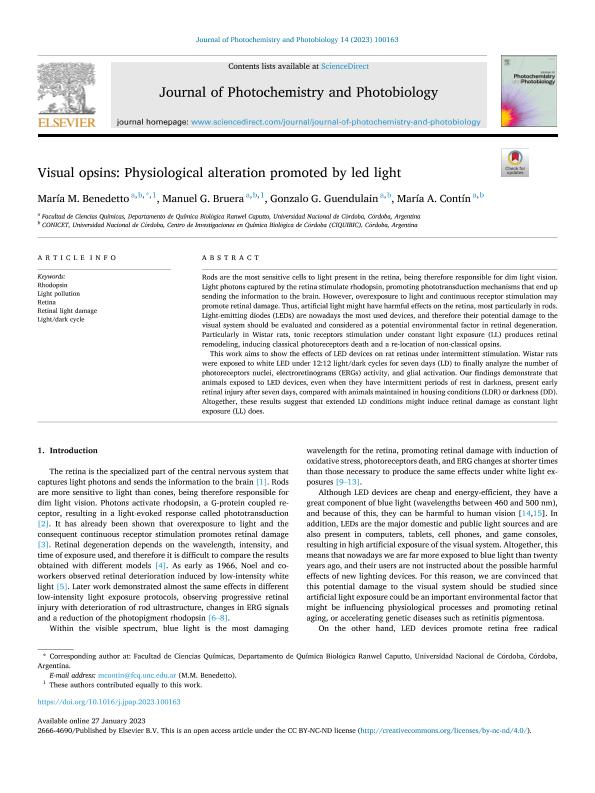Artículo
Visual opsins: Physiological alteration promoted by led light
Fecha de publicación:
04/2023
Editorial:
Elsevier
Revista:
Journal of Photochemistry and Photobiology
ISSN:
2666-4690
Idioma:
Inglés
Tipo de recurso:
Artículo publicado
Clasificación temática:
Resumen
Rods are the most sensitive cells to light present in the retina, being therefore responsible for dim light vision. Light photons captured by the retina stimulate rhodopsin, promoting phototransduction mechanisms that end up sending the information to the brain. However, overexposure to light and continuous receptor stimulation may promote retinal damage. Thus, artificial light might have harmful effects on the retina, most particularly in rods. Light‐emitting diodes (LEDs) are nowadays the most used devices, and therefore their potential damage to the visual system should be evaluated and considered as a potential environmental factor in retinal degeneration. Particularly in Wistar rats, tonic receptors stimulation under constant light exposure (LL) produces retinal remodeling, inducing classical photoreceptors death and a re-location of non-classical opsins. This work aims to show the effects of LED devices on rat retinas under intermittent stimulation. Wistar rats were exposed to white LED under 12:12 light/dark cycles for seven days (LD) to finally analyze the number of photoreceptors nuclei, electroretinograms (ERGs) activity, and glial activation. Our findings demonstrate that animals exposed to LED devices, even when they have intermittent periods of rest in darkness, present early retinal injury after seven days, compared with animals maintained in housing conditions (LDR) or darkness (DD). Altogether, these results suggest that extended LD conditions might induce retinal damage as constant light exposure (LL) does.
Palabras clave:
LIGHT POLLUTION
,
LIGHT/DARK CYCLE
,
RETINA
,
RETINAL LIGHT DAMAGE
,
RHODOPSIN
Archivos asociados
Licencia
Identificadores
Colecciones
Articulos(CIQUIBIC)
Articulos de CENTRO DE INVEST.EN QCA.BIOL.DE CORDOBA (P)
Articulos de CENTRO DE INVEST.EN QCA.BIOL.DE CORDOBA (P)
Citación
Benedetto, Maria Mercedes; Bruera, Manuel Gaston; Guendulain, Gonzalo Germán; Contin, Maria Ana; Visual opsins: Physiological alteration promoted by led light; Elsevier; Journal of Photochemistry and Photobiology; 14; 4-2023; 1-6
Compartir
Altmétricas




